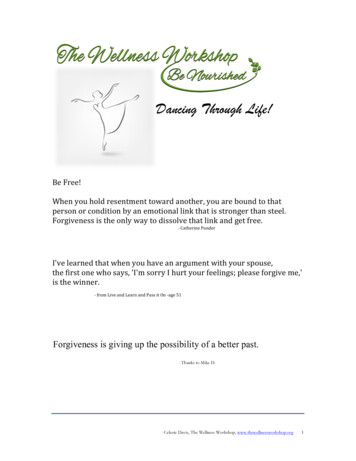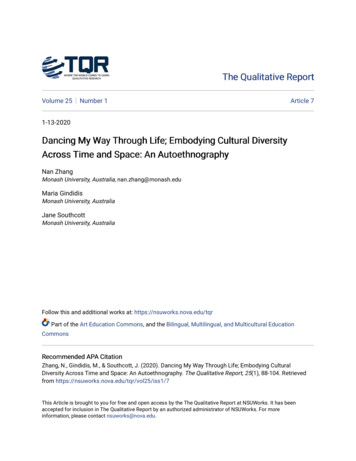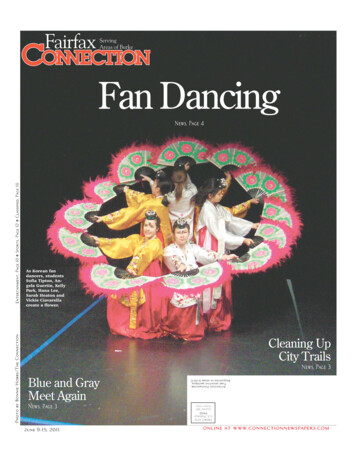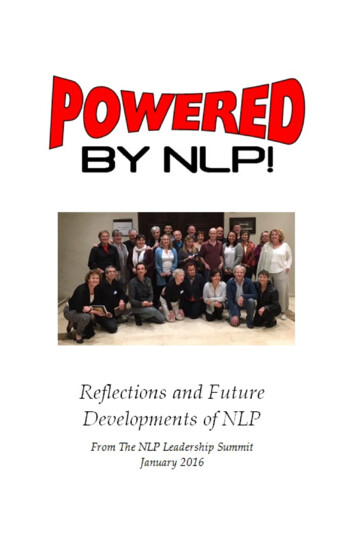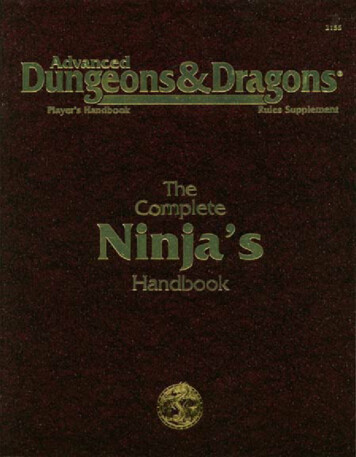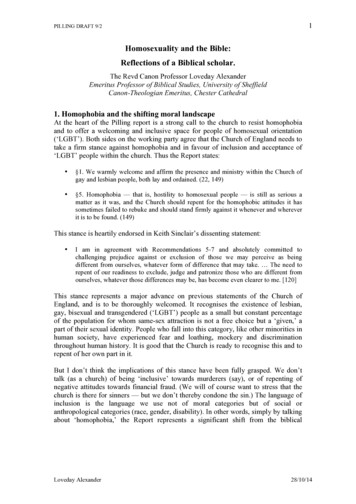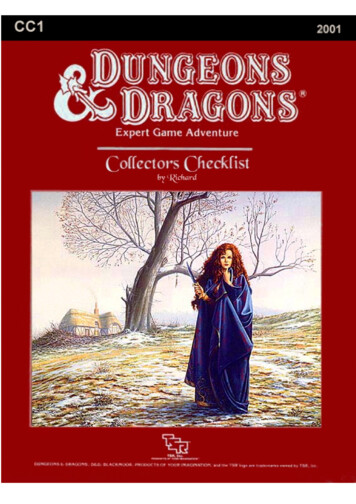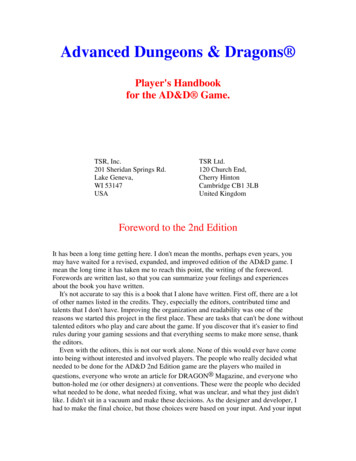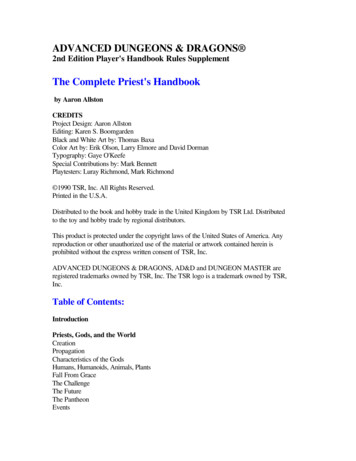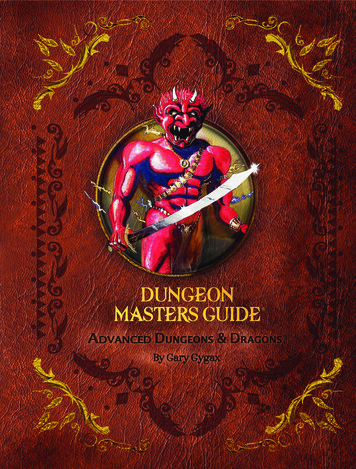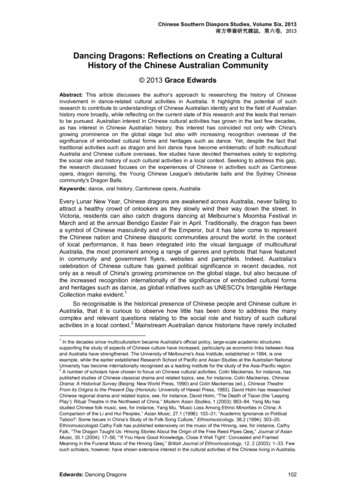
Transcription
Chinese Southern Diaspora Studies, Volume Six, 2013南方華裔研究雜誌, 第六卷, 2013Dancing Dragons: Reflections on Creating a CulturalHistory of the Chinese Australian Community 2013 Grace EdwardsAbstract: This article discusses the author’s approach to researching the history of Chineseinvolvement in dance-related cultural activities in Australia. It highlights the potential of suchresearch to contribute to understandings of Chinese Australian identity and to the field of Australianhistory more broadly, while reflecting on the current state of this research and the leads that remainto be pursued. Australian interest in Chinese cultural activities has grown in the last few decades,as has interest in Chinese Australian history; this interest has coincided not only with China'sgrowing prominence on the global stage but also with increasing recognition overseas of thesignificance of embodied cultural forms and heritages such as dance. Yet, despite the fact thattraditional activities such as dragon and lion dance have become emblematic of both multiculturalAustralia and Chinese culture overseas, few studies have devoted themselves solely to exploringthe social role and history of such cultural activities in a local context. Seeking to address this gap,the research discussed focuses on the experiences of Chinese in activities such as Cantoneseopera, dragon dancing, the Young Chinese League's debutante balls and the Sydney Chinesecommunity's Dragon Balls.Keywords: dance, oral history, Cantonese opera, AustraliaEvery Lunar New Year, Chinese dragons are awakened across Australia, never failing toattract a healthy crowd of onlookers as they slowly wind their way down the street. InVictoria, residents can also catch dragons dancing at Melbourne’s Moomba Festival inMarch and at the annual Bendigo Easter Fair in April. Traditionally, the dragon has beena symbol of Chinese masculinity and of the Emperor, but it has later come to representthe Chinese nation and Chinese diasporic communities around the world. In the contextof local performance, it has been integrated into the visual language of multiculturalAustralia, the most prominent among a range of genres and symbols that have featuredin community and government flyers, websites and pamphlets. Indeed, Australia’scelebration of Chinese culture has gained political significance in recent decades, notonly as a result of China's growing prominence on the global stage, but also because ofthe increased recognition internationally of the significance of embodied cultural formsand heritages such as dance, as global initiatives such as UNESCO's Intangible Heritage1Collection make evident.So recognisable is the historical presence of Chinese people and Chinese culture inAustralia, that it is curious to observe how little has been done to address the manycomplex and relevant questions relating to the social role and history of such cultural2activities in a local context. Mainstream Australian dance historians have rarely included1In the decades since multiculturalism became Australia's official policy, large-scale academic structuressupporting the study of aspects of Chinese culture have increased, particularly as economic links between Asiaand Australia have strengthened. The University of Melbourne's Asia Institute, established in 1994, is oneexample, while the earlier established Research School of Pacific and Asian Studies at the Australian NationalUniversity has become internationally recognised as a leading institute for the study of the Asia-Pacific region.2A number of scholars have chosen to focus on Chinese cultural activities. Colin Mackerras, for instance, haspublished studies of Chinese classical drama and related topics, see, for instance, Colin Mackerras, ChineseDrama: A Historical Survey (Beijing: New World Press, 1990) and Colin Mackerras (ed.), Chinese Theatre:From its Origins to the Present Day (Honolulu: University of Hawaii Press, 1983). David Holm has researchedChinese regional drama and related topics, see, for instance, David Holm, “The Death of Tiaoxi (the 'LeapingPlay’): Ritual Theatre in the Northwest of China,” Modern Asian Studies, 1 (2003): 863–84. Yang Mu hasstudied Chinese folk music, see, for instance, Yang Mu, “Music Loss Among Ethnic Minorities in China: AComparison of the Li and Hui Peoples,” Asian Music, 27.1 (1996): 103–31; “Academic Ignorance or PoliticalTaboo?: Some Issues in China’s Study of its Folk Song Culture,” Ethnomusicology, 38.2 (1994): 303–20.Ethnomusicologist Cathy Falk has published extensively on the music of the Hmong, see, for instance, CathyFalk, “The Dragon Taught Us: Hmong Stories About the Origin of the Free Reed Pipes Qeej,” Journal of AsianMusic, 35.1 (2004): 17–56; “‘If You Have Good Knowledge, Close It Well Tight’: Concealed and FramedMeaning in the Funeral Music of the Hmong Qeej,” British Journal of Ethnomusicology, 12. 2 (2003): 1–33. Fewsuch scholars, however, have shown extensive interest in the cultural activities of the Chinese living in Australia.Edwards: Dancing Dragons102
Chinese Southern Diaspora Studies, Volume Six, 2013南方華裔研究雜誌, 第六卷, 2013the experiences of Chinese performers or students and only a handful of scholars havediscussed aspects of Chinese socio-artistic culture in Australia in a more specialisedcontext; those who have done so have generally chosen to focus on events after World3War II, particularly in work since the 1980s, and many questions remain unanswered.How, for example, have the local Chinese reworked inherited cultural forms such asdragon dance and Cantonese opera over the course of Australia’s history, a history thathas often called for resourcefulness and adaptation on the part of this community? Inwhat ways and why has the public history of such activities been remembered and/orforgotten? What does this say about our present-day association of these activities withrecent migration and the post-World War II era? Have local hybrid traditions such asSydney’s Dragon Balls garnered more or less attention than they merit, and how can anin-depth consideration of their historical role alter and inform our understanding ofChinese Australian identity? This article reflects on my approach to researching thehistory of Chinese Australian involvement in dance-related cultural activities, focusing onthe experiences of Chinese in activities such as Cantonese opera, dragon dancing, theYoung Chinese League's debutante balls, and the Sydney Chinese community's DragonBalls. In particular, it will explore the complex relationship between the historian and hersources in the process of constructing a cultural history.Following historian Jennifer Cushman’s call in her 1984 paper “A Colonial Casualty”to “relocate the Chinese experience within the Chinese community itself”, the currentgeneration of historians has emphasised histories told from within the Chinese Australian4community: stories of survival, friendship, adaptation and even love across racial lines.The oral histories of Diana Giese, Morag Loh, Wendy Lowenstein and Janis Wilton havecapitalised on the new openness of ageing members of the Chinese Australiancommunity to record stories about early Chinese settlement that would otherwise have5been lost. Meanwhile, historians working in areas beyond living memory have developeda range of techniques to counter the scarcity and fragmented nature of archival sourcescreated by the Chinese themselves; the writings of Jane Lydon and Keir Reeves havedemonstrated the value of an interdisciplinary approach to historical questions, utilisingboth archaeological evidence and documentary sources to piece together the respectivehistories of the early twentieth century Chinese hub, Sydney’s Rocks, and the nineteenth6century Mount Alexander gold field. The localised scope of these histories – also thehallmark of Barry McGowan’s study of Chinese migration and settlement in the Riverinaand Murray regions, Tracking the Dragon, and Janis Wilton’s history of the Chinese in3Lynn Fisher, for instance, discussed the experience of Susan Wang, a popularly acclaimed Chinese danceartist and post-war migrant who has faced difficulties with restrictive funding criteria attached to multiculturalism,while Gary Lester focused his research on the acclaimed choreographer Kai Tai Chan; see Lynn Fisher, “FromCultural Revolutionary Dancer to Sandgroper Choreographer: The Transformation of Susan Wang,” in Chinesein Australia and New Zealand: A Multidisciplinary Approach, ed. Jan Ryan (New Delhi: New Age InternationalPublishers Wiley Eastern, 1995), pp. 54–8; Gary Lester, “Kai Tai Chan: A Different Path”, Ph. D. thesis, DeakinUniversity, 2000.4Jennifer W. Cushman, “A ‘Colonial Casualty’: The Chinese Community in Australian Historiography,” AsianStudies Association of Australia Review, 7 (1984): 100–13.5Diana Giese, Astronauts, Lost Souls and Dragons: Voices of Today’s Chinese Australians (St Lucia: Universityof Queensland Press, 1997); Diana Giese and National Library of Australia, Beyond Chinatown: ChangingPerspectives on the Top End Chinese Experience (Canberra: National Library of Australia, 1995); Survival andCelebration: An Insight into the Lives of Chinese Immigrant Women, European Women Married to Chinese andTheir Female Children in Australia from 1856 to 1986 (Melbourne: M. Loh and C. Ramsay, 1986); WendyLowenstein, The Immigrants (Ringwood, Vic: Penguin, 1991); Janis Wilton, “Chinese Voices, Australian Lives:Oral History and the Chinese Contribution to Glen Innes, Inverell, Tenterfield and Surrounding Districts Duringthe First Half of the Twentieth Century”, Ph. D. thesis, University of New England, 1996.6Jane Lydon, “Many Inventions”: The Chinese in the Rocks, Sydney 1890–1930 (Clayton, Vic: MonashUniversity, Department of History, 1999); Jane Lydon, “The Chinese Community in The Rocks Area of Sydney:Cultural Persistence and Exchange,” in The Overseas Chinese in Australasia: History, Settlement andInteractions: Proceedings, ed. Henry Chan, Ann Curthoys and Nora Chiang (Taipei: Interdisciplinary Groupfor Australian Studies; Canberra: National Taiwan University and Centre for the Study of the Chinese SouthernDiaspora, 2001), pp. 17–24, 152–3; Keir Reeves, “A Hidden History: The Chinese on the Mount AlexanderDiggings, Central Victoria, 1851–1901,” Ph. D. thesis, University of Melbourne, 2006.Edwards: Dancing Dragons103
Chinese Southern Diaspora Studies, Volume Six, 2013南方華裔研究雜誌, 第六卷, 2013regional New South Wales, Golden Threads – has proven a highly effective way for7scholars of Chinese Australian history to overcome the issue of source material. Stillothers, notably Kate Bagnall and John Fitzgerald, have gone back to the archives to8retrieve Chinese voices hidden among the records. Perhaps the most famous history ofthis kind is Fitzgerald’s Big White Lie, published in 2007, in which he argues successfullyagainst writers such as Keith Windschuttle in emphasising the democratic “Australian”9spirit exhibited in the petitions, letters and articles left behind by the Chinese. Together,these approaches have recovered much of the richness of the Chinese Australiannarrative.The powerful window into this history that engagement with Chinese culturalactivities can offer has become better acknowledged with the establishment of theMuseum of Chinese Australian History in Melbourne and the Golden Dragon Museum in10Bendigo. The importance of the late nineteenth-century processional and musicalcollections of the Golden Dragon Museum, which include the world’s oldest processionaldragon and costumes used by the Chinese in the 1882 Bendigo Easter Fair, hasencouraged museum staff and researchers to study these collections in detail.Associated community history societies and their publications have also added to bothpublic and scholarly awareness of the histories of specific Chinese communities withinAustralia. The fruitful partnership of these organisations with scholars interested inaspects of Chinese social life can be seen in Amanda Rasmussen’s research on theBendigo Easter Fair and Tsanhuang Tsai’s research into the Golden Dragon Museum’s11musical collections. Outside of these institutions, Harold Love’s 1985 study of Chinesetheatres in Victoria remains a groundbreaking contribution in this area, while JohnFitzgerald, Jan Ryan and Mei-fen Kuo have all made equally important, though less12specialised, contributions to the history of the cultural activities of the Chinese. Relatedstudies on Chinese religious practices and temples in Australia by Toylaan Ah Ket, Hu JinKok and Gordon Grimwade have also contributed valuable information about the ways inwhich the Chinese perceived their world and contextualised their rituals and cultural13activities. When considered alongside studies from fields as diverse as economics anddigital art and media, they constitute a considerable body of literature such that Chinese14Australian historians can no longer claim that the field is undervalued or neglected.7Barry McGowan, Tracking the Dragon: A History of the Chinese in the Riverina (Wagga Wagga: Museum ofthe Riverina, 2010); Janis Wilton, Golden Threads: The Chinese in Regional New South Wales, 1850–1950(Armidale: New England Regional Art Museum in association with the Powerhouse Museum, 2004).8Kate Bagnall, “Golden Shadows on a White Land: An Exploration of the Lives of White Women Who PartneredChinese Men and Their Children in Southern Australia, 1855-1915,” Ph. D. thesis, University of Sydney, 2006;John Fitzgerald, Big White Lie: Chinese Australians in White Australia (Sydney: University of New South WalesPress, 2007).9Fitzgerald, Big White Lie; Keith Windschuttle, The White Australia Policy (Paddington: Macleay Press, 2004).10See, for instance, Bendigo Chinese Association & Golden Dragon Museum, The Golden Dragon MuseumPresents the 1880s Processional Regalia of the Bendigo Chinese Association (Bendigo: Golden DragonMuseum, 2010); Chinese Procession: Easter in Bendigo (Bendigo: Golden Dragon Museum, 2003).11Amanda Rasmussen, “Networks and Negotiations: Bendigo’s Chinese and The Easter Fair,” Journal ofAustralian Colonial History, 6 (2004): 79–92. Tsanhuang Tsai’s work on “Relational Instruments: How Bendigo'sPast Soundscape is Shaping its Present and Future” is yet to be published, see http://hrc.anu.edu.au/2011visiting-fellows, accessed 14 December 2011.12Harold Love, “Chinese Theatre on the Victorian Goldfields, 1858–1870,” Australasian Drama Studies, 3.2(1985): 45–86; Fitzgerald, Big White Lie, pp. 115–26; Jan Ryan, Chinese Women and the Global Village (StLucia: University of Queensland Press, 2003); Mei-fen Kuo, “Making Chinese Australia: The Role of SydneyChinese Community, 1892-1912,” Ph.D. thesis, La Trobe University, 2008.13Toylaan Ah Ket, Chinese Religious Practice in Sydney, 1850-1981: Changes to Traditions in the 20th CenturyResulting from Encounters with Australian Culture and Christianity (Melbourne: Chinese Museum, 1999);Gordon Grimwade, Cairns Museum and Cairns Historical Society, Lit Sung Goong: Chinese Religious Practicesin Cairns, North Queensland, Records of Cairns Museum No. 2 (Cairns: Cairns Museum, 1985); Hu Jin Kok,Chinese Temples in Australia: Hall of the Ranking Sages, vol. 4 (Bendigo: Bendigo Golden Dragon Museum,2005).14As a starting point, see, for instance, Tseen Khoo (ed), Locating Asian Australian Cultures (London and NewYork: Routledge, 2008) and Helen Gilbert, Tseen Khoo and Jacqueline Lo (eds), Diaspora: Negotiating AsianAustralia (Brisbane: University of Queensland Press, 2000).Edwards: Dancing Dragons104
Chinese Southern Diaspora Studies, Volume Six, 2013南方華裔研究雜誌, 第六卷, 201315Given these relatively recent developments, the continued lack of inclusion ofChinese dance traditions within mainstream artistic narratives becomes difficult toexplain. Early histories of dance in Australasia, perhaps unsurprisingly, tended toemphasise a European dance heritage. Edward Pask’s important Enter The ColoniesDancing (1979), for instance, primarily features ballet, while Nell Challingsworth’sDancing Down the Years (1978) focuses on nineteenth-century European-style balls and16dance parties. Maurice Hurst’s Music and the Stage in New Zealand, meanwhile, givesa popular account of nineteenth and early twentieth century entertainments such as17vaudeville, ballet, song and pantomime.However, more recent dance historiesfrequently mention the pioneering influence of the post-war Jewish refugees who broughttheir expressionist modern dance traditions with them, and acknowledge the local18significance of importations such as American jazz and the Argentinean tango.Interest in indigenous dance forms in both Australia and New Zealand has alsogrown since the 1970s. The Maori Action Song has received scholarly attention fromdance anthropologist Jennifer Shennan and the ever-iconic haka has received attention19more recently from Wira Gardner. Kapa Haka is now a standard subject in many highschools around New Zealand and there are also courses available at major tertiary20institutions such as the University of Auckland, as well as in the private sector. PaulDiamond’s biography of New Zealand’s most famous Maori dance figure, Makureti(Maggie) Papakura, offers a welcome biographical contribution to the history of New21Zealand dance.In Australia, the profile of indigenous companies, most notablyBangarra Dance Theatre, has increased popular interest in indigenous dance and notable22scholarly contributions have come from Amanda Card and Raymond Stanley Robinson.The absence of the Chinese within this literature seems quite at odds with themovement of dance studies away from Anglo-centric narratives – if the Chinese representthe largest non-indigenous, non-European migrant group in Australasia and one of the15Prior to the most recent decade, topics such as migration and settlement, assimilation, and stories of violenceand discrimination were the major focus of Australasian scholars studying the Chinese, see C. Y. Choi, ChineseMigration and Settlement in Australia (Sydney: Sydney University Press, 1975); C. F. Yong, The New GoldMountain: The Chinese in Australia, 1901–1921 (Richmond: Raphael Arts, 1977); Myra Willard, History of theWhite Australia Policy to 1920, 2nd ed. (Melbourne: Melbourne University Press, 1967); Bickleen Ng Fong, TheChinese in New Zealand: A Study in Assimilation (Hong Kong: Hong Kong University Press, 1959); NigelMurphy, The Poll-Tax in New Zealand (Wellington, N.Z: Office of Ethnic Affairs, Department of Internal Affairs,2002); Nigel Murphy, Guide to Laws and Policies Relating to the Chinese in New Zealand 1871–1997(Wellington, N.Z.: New Zealand Chinese Association, 2008); Kathryn Cronin, Colonial Casualties: Chinese inEarly Victoria (Melbourne: Melbourne University Press, 1982).16Edward H. Pask, Enter the Colonies, Dancing: A History of Dance in Australia, 1835–1940 (Melbourne:Oxford University Press, 1979); Nell Challingsworth, Dancing Down the Years: The Romantic Century inAustralia (Melbourne: Craftsman Press, 1978).17Maurice Hurst, Music and the Stage in New Zealand: A Century of Entertainment, 1840–1943 (Auckland:Charles Begg, 1944).18See, for instance, Pask, Enter the Colonies, Dancing; Challingsworth, Dancing Down the Years; Jordan BethVincent, “In Pursuit of a Dancing ‘Body’: Modernity, Physicality and Identity in Australia, 1919 to 1939,” Ph. D.thesis, University of Melbourne, 2009.19Jennifer Shennan, The Maori Action Song: Waiata a Ringa, Waiata Kori, no Whea Tenei Ahua Hou?(Wellington: New Zealand Council for Educational Research, 1984); Wira Gardner, Haka: A Living Tradition(Auckland: Hodda Moa Beckett, 2002).20See, for instance, The University of Auckland, “Maori Studies,” course guide, available online ct MAORI, accessed 15 August 2011.21Tara Jahn-Werner, Dance: The Illustrated History of Dance in New Zealand (Auckland: Random House,2008); Paul Diamond, Makureti: Taking Maori to the World (Auckland: Random House, 2007).22Raymond Stanley Robinson et al., “Dreaming Tracks: History of the Aboriginal Islander Skills DevelopmentScheme, 1972–1979 – Its Place in the Continuum of Australian Indigenous Dance and the Contribution of itsAfrican American Founder, Carole Y. Johnson,” Ph. D. thesis, University of Western Sydney, 2000; AmandaCard, “From Aboriginal Dance to Aboriginal Dancing: The Appropriation of the Primitive in Australian Dance,” inProceedings of the Society of Dance History Scholars (Minneapolis: University of Minnesota Press, 1996).Edwards: Dancing Dragons105
Chinese Southern Diaspora Studies, Volume Six, 2013南方華裔研究雜誌, 第六卷, 2013most historically significant, why do the Chinese not seem to merit even a cursory23mention in local dance histories?I suggest that while the historical presence of the Chinese in Australia is becomingmore well known, Chinese culture is still seen as foreign, both geographically andpsychologically. The anthropological interest in indigenous dance culturesnotwithstanding, the legacy of White Australia is arguably present in the tendency toassume greater kinship with lighter-skinned white migrant cultures while relegating often24longstanding non-European migrant traditions to the status of “ethnic history”. HistoricalWestern depictions of the Orient remain influential in contemporary discoursesconcerning the Chinese diaspora. While dragon dances and annual festivals celebrate25Chinese culture, they are generally viewed as portals into a distant and exotic world.School groups are attracted by the opportunity to learn about the traditional customs andhistory of China, which seem to bear little direct relevance to their own lives except as apoint of curiosity; the fact that these traditions have been adapted for performance withincontemporary Australia, are funded by Australian organisations and often involve nonChinese participants and organisers is temporarily forgotten.For me, taking on the task of recovering the cultural history of the ChineseAustralian community has generated deep reflection about what such a history shouldinclude. Simply narrowing down my choice of dance events proved a difficult task, for inthe process of selection I became highly aware of my role in promoting a particular viewof Chinese Australian identity. Should I include traditional Chinese genres such asCantonese opera despite the fact that to Western scholars such a genre does not fitneatly into the category of dance? Should I include Western traditions such as ballet, jazzand social dance in a history of the Chinese? How do I decide which genres are the mostworthy of study and which will help create the most nuanced depictions of ChineseAustralian experiences? My decision to cover an unusually large period of time (about ahundred years) hopes to draw attention to the varied and changing nature of identitieswithin the Chinese community. I tackle this breadth by adopting a case study approach,narrowing my focus to three specific traditions I have deemed most historically significantto the Chinese community: nineteenth-century Cantonese opera in Victoria, debutanteballs in the White Australia era and the longstanding dragon dance, along with itsaccompanying processions.Jan Ryan, writing in 1995, contended that the myth of a single Chinese identity, asopposed to a single Australian identity, is still pervasive and prevents the contrasting and26multidimensional experiences of Chinese people from being appreciated. ZhengtingWang’s history of Chinese music in Victoria, currently the only scholarly history of its kind,appears to support Ryan’s claim, restricting its scope only to traditions deemed to be23Cantonese opera arrived in Australia in 1858 at the latest, dragon dance has delighted audiences in theAntipodes since at least the late nineteenth century, and both the Sydney and Melbourne Chinese debutanteballs, which began in the late 1930s, can claim to have lasted almost continuously until the 1970s and 1980srespectively. Love, “Chinese Theatre on the Victorian Goldfields, 1858–1870”; Rasmussen, “Networks andNegotiations: Bendigo’s Chinese and The Easter Fair”; “Young Chinese League debutante balls,” ChineseAustralian Historical Images in Australia, available online 05b.htm, accessed 10 April 2012; d/Lux/Media Arts inassociation with 4A Centre for Contemporary Asian Art, the Powerhouse Museum and the Project Factory;“Dragon Balls,” China Heart website, available online at http://www.chinaheart.org.au/flow-7.3.php, accessed 10April 2012. Note that the Dragon Festival Ball continued at least several years longer than the end date listed onthe China Heart website, and I have interviewed debutantes who have participated as late as 1976.24Gavin W. Jones, “White Australia, National Identity and Population Change,” in Legacies of White Australia:Race, Culture and Nation, ed. Laksiri Jayasuriya, David Walker and Jan Gothard (Crawley: University ofWestern Australia Press, 2003), p. 114.25The British fascination with China first saw a peak in the eighteenth century with the large-scale trade andconsequent importation of silks, tea and luxury items. Another wave of interest followed the Opium War andagain in the 1920s and 30s. For a more in-depth discussion on this topic, see David Porter, The Chinese Tastein Eighteenth-Century England (Cambridge and New York: Cambridge University Press, 2010).26Jan Ryan, “Chinese Australian History,” in Creating Australia: Changing Australian History, ed. WayneHudson and Geoffrey Bolton (Sydney: Allen & Unwin, 1997), p. 73.Edwards: Dancing Dragons106
Chinese Southern Diaspora Studies, Volume Six, 2013南方華裔研究雜誌, 第六卷, 201327typically “Chinese”. The relatively low level of awareness of Chinese involvement innon-traditional Chinese activities also supports this conclusion. Despite the popularity andlongevity of the debutante ball tradition within the Chinese community, for instance, thetradition has only received cursory treatment in the historical literature, generally as anexample of the Westernised tendencies of second and third generation Chinese growing28up during the White Australia period. While it might be tempting to dismiss a traditionsuch as the Chinese debutante balls as frivolous, a naive form of Western imitation or as29a “fantasy” of assimilation, the longevity of the tradition suggests that it in fact servedmultiple important purposes. Because of this, I have chosen to discuss the historicalsignificance and role played by the balls within the Chinese community at length, despitethe ritual’s more familiar association with British tradition. My work can therefore best beunderstood as a history of the Chinese community’s engagement with dance (in thebroadest sense) in Australia, rather than a local history of “Chinese dance”.“Chinese Dramatic Characters,” Australian Monthly Magazine, October 1865, p. 88My unusual approach necessarily means that my research methods must vary tosuit the period on which I am focusing. Interested colleagues and members of the publicoften assume my major primary source will be actual dances; however, this is neitherfeasible nor appropriate. Dances are by nature ephemeral and the performancesdiscussed in my thesis are long gone. Historians working in the fields of music history,literary history and art history will usually have at least a score, image or written piece asa basis for their investigations; for the most part, however, I am not in that position and27Zhengting Wang, Chinese Music in Australia – Victoria: 1850s to mid-1990s (Melbourne: Australia AsiaFoundation, 1997).28Ryan, Chinese Women, pp. 135 and 142.29ibid, p. 142.Edwards: Dancing Dragons107
Chinese Southern Diaspora Studies, Volume Six, 2013南方華裔研究雜誌, 第六卷, 2013must therefore chase fragments left behind in all sorts of archives, piecing everythingtogether as patiently as possible. Despite the absence of recorded dance as a source, Ibelieve there is much to be gained from the sources available by exploring the socialdimensions of class, gender and ethnic identity within the Sydney and MelbourneChinese communities rather than choreography, dance structure or genre, and I havefrequently been surprised by how much material is out there waiting to be examined.The Chinese who arrived in the mid to late nineteenth century left very few writtenrecords of their own. Government archival documents, digital repositories, such as Trovefrom the National Library of Australia, and newspapers have thus contributed significantlyto my body of research. I am indebted to Tim Sherratt for his creation of a Trove30harvester which allowed me to conduct large scale digital “harvests” of articles. Thisenabled me to gain a critical level of detail to piece together with information found inother kinds of documents such as theatrical licence applications and pictures. Such toolshave their limitations, of course, and can create a number of traps for inexperiencedresearchers. Technical limitations associated with search functions can omit or obscureimportant results, while financial limitations have delayed the digitisation of somenewspapers. Any kinds of analyses done with a computer must be treated critically for awhole host of reasons discussed at length elsewhere; however, the solution is simply tobe aware of these problems and take reasonable precautions to prevent or minimise31them. Nonetheless, it should be apparent that digital history can open up topics thatotherwise would be difficult to consider as the basis for historical research projects.In order to reconstruct the history of the Chinese debutante tradition in the WhiteAustralia era – a ritual that has been little researched and of which little evidence hasbeen formally archived – I have also relied heavily on oral history interviews. These areprimarily those I have personally conducted with members of the Melbourne and SydneyChinese community, but also those hel
Keywords: dance, oral history, Cantonese opera, Australia Every Lunar New Year, Chinese dragons are awakened across Australia, never failing to attract a healthy crowd of onlookers as they slowly wind their way down the street. In Victoria, residents can also catch d
